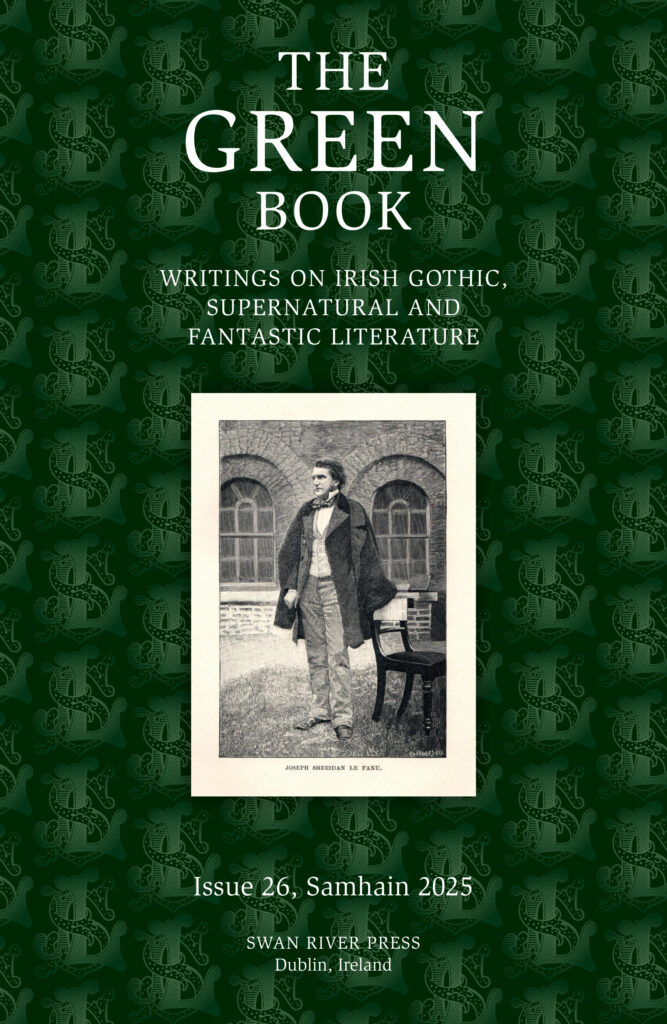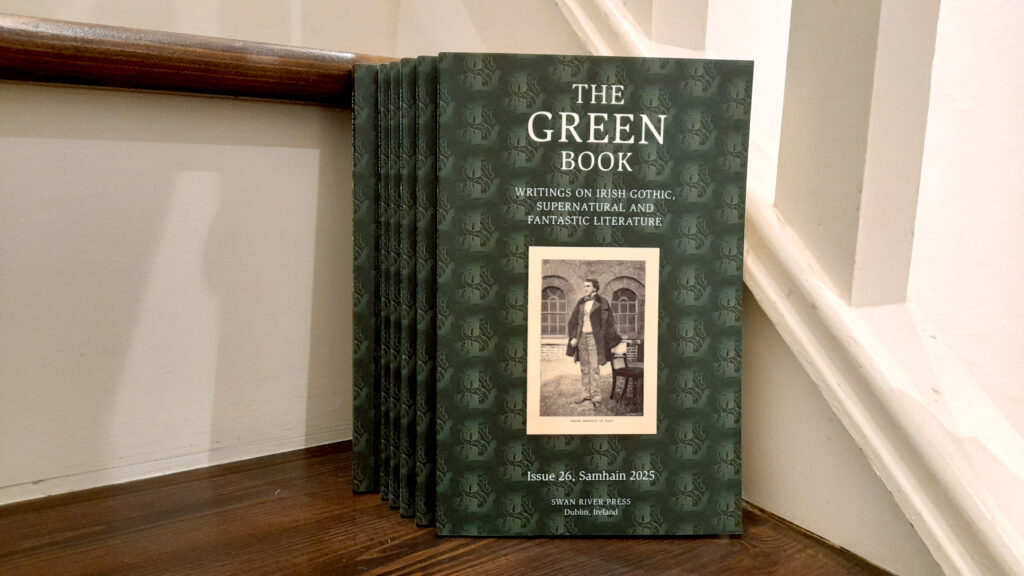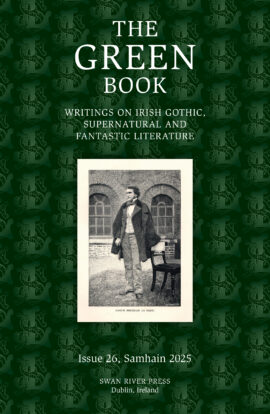The Green Book 26
Samhain 2025
Brian J. Showers (ed.)
Availability: In Print
We find ourselves with a second issue this year focusing on Joseph Sheridan Le Fanu. I had a handful of items that I couldn’t fit into the previous issue, so I hope you’ll allow me the indulgence of a few more pages. There’s some interesting stuff between these covers.
The first piece is the subject of some debate among Le Fanu scholars. The story “My Aunt Margaret’s Adventure” was first published in the Dublin University Magazine (March 1864) between the final instalments of Wylder’s Hand (February) and “Wicked Captain Walshawe, of Wauling” (April). Along with “Wicked Captain Walshawe”, “My Aunt Margaret’s Adventure” was identified by M. R. James as having been written by Le Fanu—although authorship was not explicitly stated in its original publication of the story and no known records have surfaced to confirm this conjecture.
- Looking to buy multiple issues? Check out our Green Book Bundle.
Paperback edition limited to 250 copies.
Cover art: “Joseph Sheridan Le Fanu” by H. Fitzner Davey
Editor’s Note by Brian J. Showers
ISSN: 2009-6089 (pbk)
Contents
“Editor’s Note” – Brian J. Showers
“My Aunt Margaret’s Adventure” –Joseph Sheridan Le Fanu
“The Botheration of Billy Cormack” –Catherine Le Fanu
“Extracts from Seventy Years of Irish Life” –William R. Le Fanu
“A Void Which Cannot Be Filled Up: Obituaries of Mr. J. S. Le Fanu, Esq.” –Brian J. Showers
“Deciphering the Bennett/Le Fanu Capstone” –Brian J. Showers
“Notes on Contributors”
“Submission Guidelines”
 Editor’s Note #26
Editor’s Note #26
We find ourselves with a second issue this year focusing on Joseph Sheridan Le Fanu. I had a handful of items that I couldn’t fit into the previous issue, so I hope you’ll allow me the indulgence of a few more pages. There’s some interesting stuff between these covers.
The first piece is the subject of some debate among Le Fanu scholars. The story “My Aunt Margaret’s Adventure” was first published in the Dublin University Magazine (March 1864) between the final instalments of Wylder’s Hand (February) and “Wicked Captain Walshawe, of Wauling” (April). Along with “Wicked Captain Walshawe”, “My Aunt Margaret’s Adventure” was identified by M. R. James as having been written by Le Fanu—although authorship was not explicitly stated in its original publication of the story and no known records have surfaced to confirm this conjecture. At the time, James was compiling Madam Crowl’s Ghost and Other Tales of Mystery (1923). For that volume, James identified and reprinted a number of stories by Le Fanu that had until then been previously overlooked and uncollected, many of which were published anonymously in the first place. Although James does not state the basis upon which he draws the conclusion that “My Aunt Margaret’s Adventure” was written by Le Fanu, in a note to his prologue, he gives a definite reason for not including this tale in that volume: “[the story] belongs to a class of which I disapprove—the ghost-story which peters out into a natural explanation”.
Most scholars seem to agree that “My Aunt Margaret’s Adventure” was likely written by Le Fanu, although, as with “The Mysterious Lodger” (1850), and without firm evidence, there is ultimately a question mark beside its authorship. A Jamesian loophole of reasonable doubt. Swan River Press reprinted this story for the first time as a booklet in 2009. I’m pleased to include it again here. Once you’ve read this tale of Aunt Margaret and a sinister, remote road-side hostelry, you may draw your own conclusions.
The second item in this issue is a real curiosity: the sole known piece of published writing by Le Fanu’s sister Catherine, a story entitled “The Botheration of Billy Cormack” (November 1840). Catherine was in her late twenties when this story was published in the Dublin University Magazine, where her brother’s “Purcell Papers” were by then already familiar to the magazine’s readers. Perhaps Catherine’s story was a first attempt at a burgeoning literary career? Did Le Fanu have a hand in guiding the story to publication? This career was tragically cut off when Catherline died in March 1841, less than half a year after the story was published. The tale is set in the west of Ireland—where Joseph, Catherine, and their brother William spent their adolescence—and it draws upon that region, evoking local colour and custom. To my knowledge, this is the first time the story has been reprinted.
Similarly, William Le Fanu drew upon similar reminiscences when writing his sole book: Seventy Years of Irish Life (1893). In this memoir, William recalls his childhood, anecdotes concerning his brother Joseph, and his later career as a railroad engineer. For this issue, I’ve selected William’s memories of folklore and folk practices he encountered in his youth and on his travels throughout Ireland. For those seeking William Le Fanu’s memories of his older brother Joseph, extracts can be found reprinted in the excellent sourcebook Reflections in a Glass Darkly: Essays on J. Sheridan Le Fanu (2011); but if you’re more generally interested in Irish life and culture of by-gone days, do pick up a copy of Seventy Years of Irish Life. It’s still a charming read.
Rounding out this issue, we’ve two pieces relating to the death of Joseph Sheridan Le Fanu in February 1873. The first is a selection of obituaries, which I hope will give readers more insight as to Le Fanu’s stature and reputation at the time of his death, and how his writing was appreciated in that moment. I always find this sort of exercise fascinating because it’s the moment before obscuring mythologies take root around some authors, particularly if those authors in life revelled in horror and the gothic. And finally, we have a short piece on the now nearly-faded capstone of Le Fanu’s vault in Mount Jerome Cemetery, Dublin; and the memorial plaque that was subsequently installed for Le Fanu’s bicentenary in 2014—an attempt to stave off for a little longer the inevitable passage of time.
Brian J. Showers
Æon House, Dublin
28 August 2025
Brian J. Showers
Brian J. Showers is originally from Madison, Wisconsin. He has written short stories, articles, and reviews for magazines such as Rue Morgue, Ghosts & Scholars, and Supernatural Tales. His short story collection, The Bleeding Horse, won the Children of the Night Award in 2008. He is also the author of Literary Walking Tours of Gothic Dublin (2006), the co-editor of Reflections in a Glass Darkly: Essays on J. Sheridan Le Fanu (2011), and the editor of The Green Book. Showers also edited four volumes of Uncertainties anthology series, and co-edited with Jim Rockhill, the Ghost Story Award-winning anthology Dreams of Shadow and Smoke. He lives in Dublin, Ireland.
Read moreThe Green Book 26 (Samhain 2025) edited by Brian J. Showers. Cover art: “Joseph Sheridan Le Fanu” by H. Fitzner Davey; cover design by Meggan Kehrli; editor’s note by Brian J. Showers; edited by Brian J. Showers; copyedited by Jim Rockhill; typeset by Steve J. Shaw; published by Swan River Press at Æon House.
Paperback: Published on 1 October 2025; limited to 250 copies; 108 pages; digitally printed on 80 gsm paper; issued with one postcard; printed by CPI Antony Rowe; ISSN: 2009-6089.

 About The Green Book
About The Green Book
Aimed at a general readership and published twice-yearly, The Green Book is Swan River Press’s house journal that features commentaries, articles, and reviews on Irish Gothic, Supernatural and Fantastic literature.
Certainly favourites such as Bram Stoker and John Connolly will come to mind, but hopefully The Green Book also will serve as a pathway to Ireland’s other notable fantasists: like Fitz-James O’Brien, Charlotte Riddell, Lafcadio Hearn, William Allingham, J. Sheridan Le Fanu, Cheiro, Harry Clarke, Dorothy Macardle, Lord Dunsany, Elizabeth Bowen, C. S. Lewis, Mervyn Wall, Conor McPherson . . . and this list is by no means exhaustive.
It should be noted that the word “Irish” in the journal’s title should be understood as inclusive rather than exclusive. The Green Book will also feature essays on Irish themes—even if by non-Irish authors. We hope that you will find something of interest here, for there is much to explore.
The Green Book is open for submissions.
Praise for The Green Book
“A welcome addition to the realm of accessible nonfiction about supernatural horror.” – Ellen Datlow
“Serious aficionados of the weird should also consider subscribing to The Green Book.” – Michael Dirda
“An exceptionally well-produced periodical.” – S. T. Joshi
“[A] wonderful exploration of a weird little corner of literature, and a great example of how careful editing can make even the most obscure subject fascinating and entertaining beyond all expectations.” – The Agony Column
“Eminently readable . . . [an] engaging little journal that treads the path between accessibility and academic depth with real panache.” – Black Static
“The overall feel here is not of fusty excavation in a small corner of the literary world, but of exploration on a broad front that continues to unearth intriguing finds.” – Supernatural Tales


